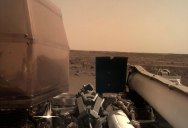“Travelled 300 Million Miles, Took This Pic”
The Instrument Deployment Camera (IDC), located on the robotic arm of NASA’s InSight lander, took this picture of the Martian surface on Nov. 26, 2018, the same day the spacecraft touched down on the Red Planet. The camera’s transparent dust cover is still on in this image, to prevent particulates kicked up during landing from settling on the camera’s lens. This image was relayed from InSight to Earth via NASA’s Odyssey spacecraft, currently orbiting Mars.
InSight, short for Interior Exploration using Seismic Investigations, Geodesy and Heat Transport, is a Mars lander designed to give the Red Planet its first thorough checkup since it formed 4.5 billion years ago. It is the first outer space robotic explorer to study in-depth the “inner space” of Mars: its crust, mantle, and core.
The lander uses cutting edge instruments, to delve deep beneath the surface and seek the fingerprints of the processes that formed the terrestrial planets. It does so by measuring the planet’s “vital signs”: its “pulse” (seismology), “temperature” (heat flow), and “reflexes” (precision tracking). [source]
NASA’s InSight Mars lander acquired this image of the area in front of the lander using its lander-mounted, Instrument Context Camera (ICC). This image was acquired on Nov. 26, 2018, Sol 0 of the InSight mission where the local mean solar time for the image exposures was 13:34:21. Each ICC image has a field of view of 124 x 124 degrees.
InSight touched down on the Red Planet after an almost seven-month, 300-million-mile (458-million-kilometer) journey from Earth. It’s mission on Mars is targeted to last two years. While the mission on Mars has just begun, the successful touchdown on the red planet was a huge accomplishment. It marks the eighth time in human history that we have successfully landed on Mars.
What was your reaction to today’s #MarsLanding? 🚀
STEP 1: Reply with a GIF or photo of your reaction
STEP 2: See how others reacted by taking a look at this @Twitter moment: https://t.co/39T6BFwgNj pic.twitter.com/6YULrFsiEs— NASA (@NASA) November 27, 2018
“We hit the Martian atmosphere at 12,300 mph (19,800 kilometers per hour), and the whole sequence to touching down on the surface took only six-and-a-half minutes,” said InSight project manager Tom Hoffman at JPL. “During that short span of time, InSight had to autonomously perform dozens of operations and do them flawlessly — and by all indications that is exactly what our spacecraft did.”

Sign up to get our BEST stories of the week straight to your inbox.





